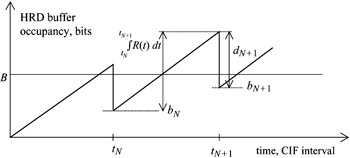6.6 Rate control
6.6 Rate control
The bit rate resulting from the DCT-based coding algorithm fluctuates according to the nature of the video sequence. Variations in the speed of moving objects, their size and texture are the main cause for bit rate variation. The objective of a rate controller is to achieve a constant bit rate for transmission over a circuit switched network. A transmission buffer is usually needed to smooth out the bit rate fluctuations, which are inherent in the interframe coding scheme.
The usual method for bit rate control is to monitor the buffer occupancy and vary the quantiser step size according to the buffer fullness [3,5]. In reference model 8 (RM8) the quantiser step size is calculated as a linear function of the buffer content and expressed by:
| (6.3) |  |
where p is the multiplier used in specifying the bit rates as in p × 64 kbit/s, and ⌊.⌋ stands for integer division with truncation towards zero.
The buffer control system usually has two additional operating states to prevent buffer underflow or buffer overflow from occurring. If the buffer content reaches the trigger point for the overflow state, current and subsequent coded data are not sent to allow the buffer to be emptied. Only trivial side information pertaining to the coded GOB or frame is transmitted.
On the other extreme, bit stuffing is invoked when buffer underflow is threatened. It is essential that buffer underflow is avoided so that the decoder can maintain synchronisation.
In practice, to allow maximum freedom of the H.261 standard codec structure, a hypothetical reference decoder (HRD) buffer is defined. All encoders are required to be compliant with this buffer. The hypothetical reference decoder is best explained with reference to Figure 6.17.

Figure 6.17: Hypothetical reference buffer occupancy
The hypothetical buffer is initially empty. It is examined at CIF intervals (1/29.97 ≅ 33 ms), and if at least one complete coded picture is in the buffer, then all the data from the earliest picture is instantly removed (e.g. at tN in Figure 6.17) [6]. Immediately after removing the above data, the buffer occupancy should be less than B, with B = 4Rmax/29.97 and Rmax being the maximum video bit rate to be used in the connection. To meet this requirement, the number of bits for (N + 1)th coded picture, dN+1 must satisfy
| (6.4) |  |
where bN is the buffer occupancy just after time tN, tN is the time at which the Nth coded picture is removed from the hypothetical reference decoder buffer and R(t) is the video bit rate at time t. Note that the time interval (tN+1 - tN) is an integer number of CIF picture periods (1/29.97, 2/29.97, 3/29.97,...).
This specification constrains all encoders to restrict the picture start lead jitters to four CIF picture period's worth of channel bits. This prevents decoder buffer overflow at the decoder in a correctly designed H.261 codec. Jitters in the opposite direction (phase lag) are not constrained by the H.261 recommendation. Phase lag corresponds to buffer underflow at the decoder, which is simply dealt with by making the decoder wait for sufficient bits to have arrived to continue decoding.
A major deficiency with the RM8/H.261 model rate controls is that bits might be unfairly distributed across the image. For example, in the active parts of the picture sequences, such as in the middle of the head-and-shoulders pictures, the buffer tends to fill up very quickly, and hence the quantiser step size rises rapidly. This causes the rest of the picture to be coded coarsely. One of the key issues in H.261, as well as in any video codec, is the way in which the quantiser step size or the rate control is managed. In the past decade numerous manufacturers have produced H.261 codecs, but they may not perform equally. Because of the need for interoperability, the general structure of H.261 must be based on coding elements as shown in Figure 6.3. Therefore the only part which makes one codec better than the others is the rate control mechanism. This part is kept secret by the manufacturers and is subject to further research.
EAN: 2147483647
Pages: 148
- An Emerging Strategy for E-Business IT Governance
- Measuring and Managing E-Business Initiatives Through the Balanced Scorecard
- A View on Knowledge Management: Utilizing a Balanced Scorecard Methodology for Analyzing Knowledge Metrics
- Measuring ROI in E-Commerce Applications: Analysis to Action
- Governing Information Technology Through COBIT
- Chapter III Two Models of Online Patronage: Why Do Consumers Shop on the Internet?
- Chapter IX Extrinsic Plus Intrinsic Human Factors Influencing the Web Usage
- Chapter X Converting Browsers to Buyers: Key Considerations in Designing Business-to-Consumer Web Sites
- Chapter XI User Satisfaction with Web Portals: An Empirical Study
- Chapter XVIII Web Systems Design, Litigation, and Online Consumer Behavior